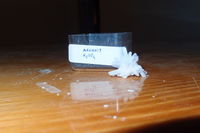Difference between revisions of "Potassium sulfate"
| Line 108: | Line 108: | ||
}} | }} | ||
}} | }} | ||
| − | '''Potassium sulfate''' ('''K<sub>2</sub>SO<sub>4</sub>''') or '''potassium sulphate''', also known as '''arcanite''', '''sulphate of potash''' or '''potash of sulfur''' is a soluble potassium salt of sulfuric acid. | + | '''Potassium sulfate''' ('''K<sub>2</sub>SO<sub>4</sub>''') or '''potassium sulphate''', also known as '''arcanite''', '''sulphate of potash''' or '''potash of sulfur''' is a soluble potassium salt of [[sulfuric acid]]. |
==Properties== | ==Properties== | ||
===Chemical=== | ===Chemical=== | ||
Potassium salt will react with [[sulfuric acid]] to form [[potassium bisulfate]]. | Potassium salt will react with [[sulfuric acid]] to form [[potassium bisulfate]]. | ||
| + | |||
| + | : K<sub>2</sub>SO<sub>4</sub> + H<sub>2</sub>SO<sub>4</sub> → 2 KHSO<sub>4</sub> | ||
| + | |||
| + | Reduction of potassium sulfate with carbon yields potassium sulfide. | ||
| + | |||
| + | : K<sub>2</sub>SO<sub>4</sub> + 4 C → K<sub>2</sub>S + 4 CO | ||
===Physical=== | ===Physical=== | ||
| Line 121: | Line 127: | ||
==Preparation== | ==Preparation== | ||
| − | Can be prepared by reacting potassium carbonate with sulfuric acid. | + | Can be prepared by reacting [[potassium carbonate]] with sulfuric acid. |
| + | |||
| + | : K<sub>2</sub>CO<sub>3</sub> + H<sub>2</sub>SO<sub>4</sub> → K<sub>2</sub>SO<sub>4</sub> + H<sub>2</sub>O + CO<sub>2</sub> | ||
==Projects== | ==Projects== | ||
| Line 132: | Line 140: | ||
===Storage=== | ===Storage=== | ||
| − | + | Potassium carbonate must be kept in closed bottles. | |
===Disposal=== | ===Disposal=== | ||
Latest revision as of 18:45, 7 December 2017

| |
| Names | |
|---|---|
| IUPAC name
Potassium sulfate
| |
| Other names
Arcanite
Potash of sulfur Potassium sulphate Sulphate of potash | |
| Properties | |
| K2SO4 | |
| Molar mass | 174.259 g/mol |
| Odor | Odorless |
| Density | 2.66 g/cm3 |
| Melting point | 1,069 °C (1,956 °F; 1,342 K) |
| Boiling point | 1,689 °C (3,072 °F; 1,962 K) |
| 111 g/L (20 °C) 120 g/L (25 °C) 240 g/L (100 °C) | |
| Solubility | Slightly soluble in glycerol Insoluble in acetone, carbon disulfide, ethanol |
| Hazards | |
| Safety data sheet | Fisher Scientific |
| Flash point | Non-flammable |
| Lethal dose or concentration (LD, LC): | |
| LD50 (Median dose)
|
6600 mg/kg (oral, rat) |
| Related compounds | |
| Related compounds
|
Potassium bisulfate |
| Except where otherwise noted, data are given for materials in their standard state (at 25 °C [77 °F], 100 kPa). | |
| Infobox references | |
Potassium sulfate (K2SO4) or potassium sulphate, also known as arcanite, sulphate of potash or potash of sulfur is a soluble potassium salt of sulfuric acid.
Contents
Properties
Chemical
Potassium salt will react with sulfuric acid to form potassium bisulfate.
- K2SO4 + H2SO4 → 2 KHSO4
Reduction of potassium sulfate with carbon yields potassium sulfide.
- K2SO4 + 4 C → K2S + 4 CO
Physical
Potassium sulfate is a white odorless solid, with a bitter taste. It is soluble in water, slightly soluble in glycerol, but insoluble in acetone, carbon disulfide, ethanol.
Availability
Potassium sulfate is available as a fertilizer, either pure or mixed with other materials.
Preparation
Can be prepared by reacting potassium carbonate with sulfuric acid.
- K2CO3 + H2SO4 → K2SO4 + H2O + CO2
Projects
- Make potassium nitrate
- Grow crystals
Handling
Safety
Potassium sulfate has little toxicity, though it be irritant.
Storage
Potassium carbonate must be kept in closed bottles.
Disposal
Can be safely dumped in soil.